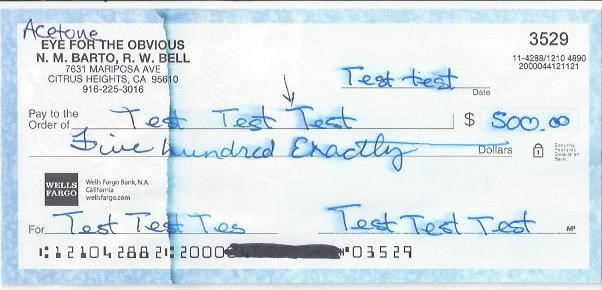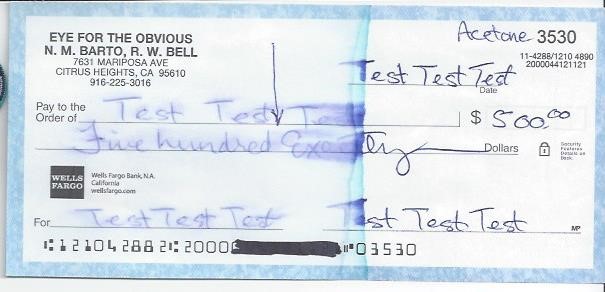Tips for Security on Check Washing
-
Thursday, February 5, 2015
Check washing was probably at the height of its time during the 1990's, but a new and interesting case that I just completed involved the claims of such a thing. The case began as a normal handwriting examination case, but as the evidence fell apart by the defendant based on handwriting, they were no longer able to keep up the ruse of forgery, thus having to declare the check must have been washed except for their signature.
The National Check Fraud Center reported in 1998, “Acetone, most widely used, is a highly volatile organic solvent used mainly as a hand-wipe solvent in cleaning applications. It is also a good drying agent for wet parts. But it will erase most inks from a stolen check without any noticeable effect.”
That was the day and age of check washing. These days it is apparent that either or both the ink industry and the paper check industry has figured out some sort of solution to squash the forgery attempts by check washers.
This is a sample of some tests completed on my own check
The check below is an acetone test on fountain pen ink. The 100% pure acetone had little effect on the washing of the ink. The arrow above the “T” in the pay to the order of line is the point where I dipped the check to, so the right side of the check was completely under the acetone for less than 49 seconds. The bleed line found on the left side of the check is the point where the acetone had wicked up to while the right side was under. The wicking occurred fairly quickly with no way of stopping it, and left a bold visual display of what will occur if only a portion of the check is dipped in the acetone in order to spare the signature.
Acetone test on fountain pen ink

The check below here is an acetone wash on a ball point pen or oil based ink. The left side of the check was dipped this time up to the arrow, and the bleed line fell to the right side of the check. The acetone was far more effective in washing the ball point ink; however, the wicking problem remained the same, and clearly not all of the ball point pen ink was able to be cleared before the signature line became affected due to the wicking.
acetone wash on a ball point pen or oil based ink

This was confirmation that there would have been some trace or remnant that would indicate an attempted washing. Not only is there still apparent ink residue left behind from the original writing, but the bleed line is undeniable.
I was a victim of check washing in 2000
I was a victim of check washing in 2000, long before I became a document examiner, so I have my own personal reference for this type of forgery. The check washers were unable to completely wash away the information written by me on the check. This forced them to overwrite some of the initial information such as the memo section and my signature. It was horribly done, and very obvious that there was some sort of foul play at hand. I am surprised now that the fraud department in my bank even needed me to file an affidavit of fraud, sign my name a million times, and dispute the charges. I can still see this check in my mind, the writing, washing and over writing that I witnessed that was involved. It didn’t take a professional to see what had occurred, and the driver license number that was listed did not match mine.
I was vindicated and my monies refunded, but it almost cost me an all-expense paid trip to the Bahamas that I had been working for, and that is probably why it is such a vivid memory. Justice prevailed, and I attended that trip 5 months later, but the work involved with straightening it out was time consuming and anxiety ridden.
If you are a ballpoint pen lover, switch to black ink when security is important
I could not imagine if this had happened with something really important like a real estate deed or another life determining document. There is a simple fix that I learned during this examination. It turns out that while the fountain pen ink is washing resistant, gel pens are impervious to check washing per the National Check Fraud Center whereby they warn, “If you are a ballpoint pen lover, switch to black ink when security is important. Among water-based inks, remember that gels are the most impervious. But when you're writing checks to pay the monthly bills, only one type of ink, the kind in gel pens, has been found to be counterfeit proof to acetone or any other chemical used in "check washing." Most ballpoint and marker inks are dye based, meaning that the pigments are dissolved in the ink.
use a gel pen, like the Uniball 207
Based on recent ink security studies, we highly recommend that you use a gel pen, like the Uniball 207 that uses gel ink that contains tiny particles of color that are trapped into the paper, making check washing a lot more difficult. The pen sells for about $2. Personally I sign all my checks and important documents with one. But if you don't want to switch, do not hesitate to use your favorite fountain pen. Just fill it with ink in one of the more durable colors and enjoy!”